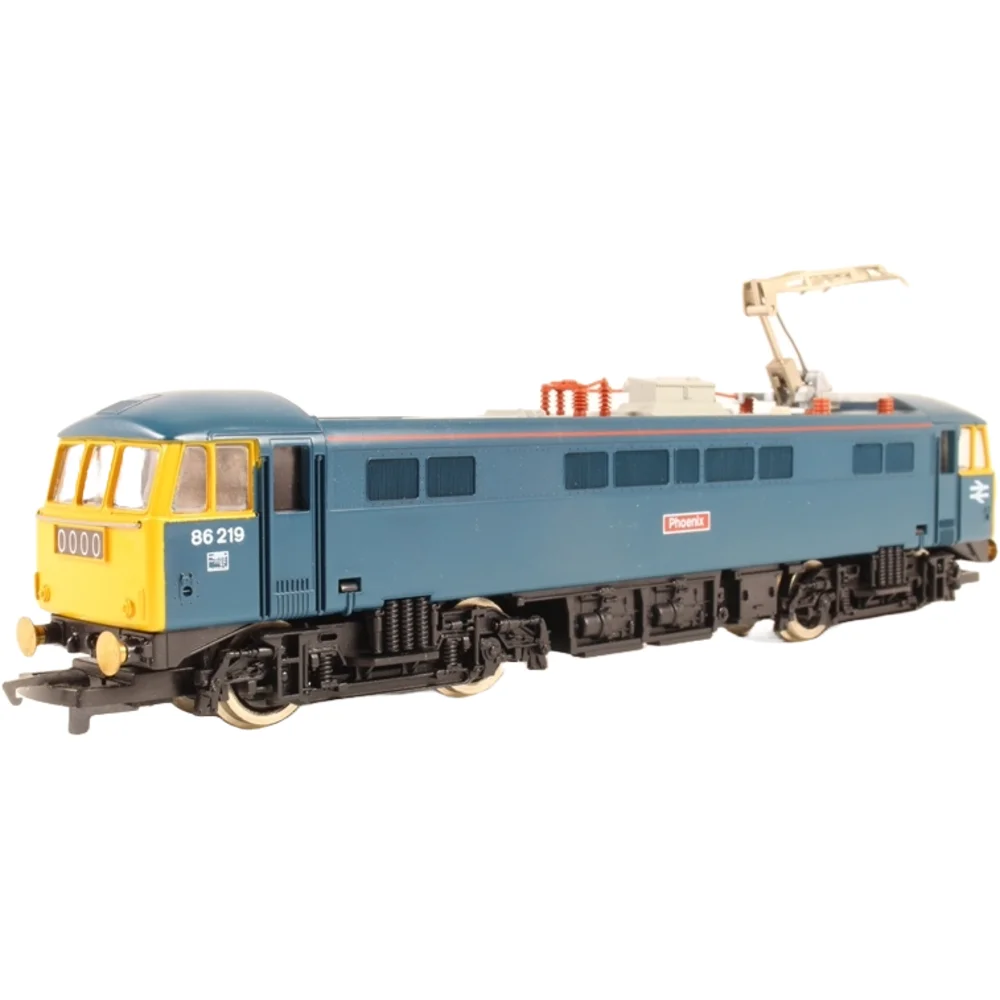Hornby R360
British Rail Class 86 86219 "Phoenix" British Rail Blue
Tooling
Hornby introduced its first British Rail Class 86 model in 1981, marking a significant addition to its OO gauge electric locomotive range. The Class 86, originally designated AL6, was a cornerstone of British Rail’s West Coast Main Line electrification programme during the 1960s. Hornby’s model reflected growing interest in modern traction and offered enthusiasts a representation of one of BR’s most important AC electric locomotives.
Tooling Features
- Construction: Plastic bodyshell with clip-fit chassis; diecast cab interiors for added realism.
- Detailing: Factory-fitted handrails, roof-mounted electrical components, Stone Faiveley AMBR pantograph, bufferbeam detail, and clear glazing. Underframe included battery boxes and compressor detail.
- Couplings: Standard tension-lock couplers mounted on fixed sockets.
Mechanical & Electrical
- Motor: Ringfield motor mounted in one bogie.
- Drive: Power to four wheels on the motor bogie; pickups on the same bogie.
- Weighting: Internal weights incorporated for traction.
- Lighting: No working lights provided.
- Pantograph: Functional for overhead power collection; switch on roof allowed changeover between track and catenary supply.
DCC Capability
The original 1981 tooling was not DCC-ready. It operated on conventional 2-rail DC and could be converted to DCC only through hard-wiring a decoder, as no socket was provided.
Liveries Produced
Over its production life, this tooling appeared in numerous liveries, including:
- BR Blue (initial release, 1981).
- InterCity Executive and Swallow schemes (1980s–1990s).
- Sectorisation liveries: Railfreight triple grey, Parcels red/grey.
- Rail Express Systems (RES).
- Post-privatisation: EWS, Freightliner green, Anglia Railways, Virgin Trains, Network Rail.
Reviews & Commentary
At launch, the model was praised for its working pantograph and ability to run from overhead catenary, a rare feature in OO gauge. However, reviewers noted limitations in chassis engineering and detailing compared to later standards. The Ringfield motor provided adequate performance for its time, though modern enthusiasts often describe it as noisy and less refined. Despite its age, the tooling remained popular through the 1980s and 1990s, with many examples still in use on layouts today.
Media & Community Feedback
Collectors and modellers frequently discuss this tooling on forums and social media, often highlighting its nostalgic appeal and robustness. Many have undertaken upgrades, including flush glazing, improved pantographs, and DCC conversions. Videos and blogs showcase restoration projects and running sessions, reinforcing its status as a classic Hornby model.
Interesting Notes
- The model could genuinely operate from overhead wires via its pantograph, a feature phased out in later Hornby electrics.
- Early releases lacked door handles, a detail corrected in later runs.
- Produced in large quantities, making it one of Hornby’s most widely owned electric locomotive models of the era.
Class & Prototype
- Class: British Rail Class 86
- Traction: Electric
- Built: 1965-1966
- Total Built: 100
No prototype found.
Operator & Livery
- Operator: British Rail
- Livery: Blue
British Rail (1965-1997) transformed Britain's railways through revolutionary modernisation, introducing the iconic double arrow logo, Rail Blue livery, and business sectorisation. BR pioneered high-speed rail with the InterCity 125 and Advanced Passenger Train, electrified major routes, and created profitable divisions like InterCity and Network SouthEast. From steam succession through diesel and electric development to privatisation preparation, British Rail's diverse locomotive fleet, multiple livery schemes, and operational scenarios provide unparalleled variety for railway modellers across all scales and periods.
BR Blue, also known as Rail Blue or Monastral Blue, was introduced in 1965 as part of British Rail's comprehensive corporate identity overhaul that accompanied the rebranding from British Railways to British Rail. The colour was officially defined by British Standards BR28/6001 (airless spray finish) and BR28/5321 (brush finish), representing a dark, greyish blue tone specifically chosen to hide dirt and weathering effects well.
The livery was prototyped on the experimental XP64 train in 1964 before becoming the standard scheme from 1 January 1965. Rail Blue was applied to all diesel and electric locomotives with yellow warning panels (initially small, then extending to full yellow ends from 1966). The standardised application included the iconic double arrow logo and Rail Alphabet typeface, creating one of the most successful transport corporate identities of the 20th century.
The livery dominated British Rail operations for over two decades until sectorisation in the 1980s began fragmenting the unified appearance. Despite initial colour fading problems in early applications, these were resolved by the late 1970s when the Large Logo variant was introduced featuring extended yellow areas and full-height double arrow symbols. Rail Blue's enduring appeal among railway enthusiasts reflects its role as the definitive British Rail image during the organisation's most unified period.
